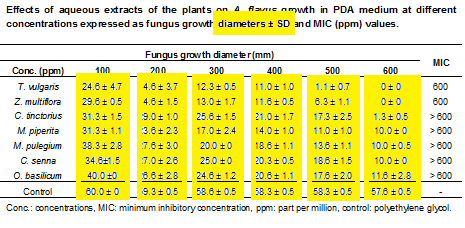
Evaluation of antifungal properties of some medicinal plants against Aspergillus flavus isolated from contaminated Corn in vitro
Abstract
Aspergillus strains especially A. flavus and A. parasiticus are the most frequent grains molds producing carcinogenic aflatoxins, which is one of the main challenges in the agriculture and food industries. Chemical pesticides for control of the fungi have adverse effects on human health and environment; therefore, the necessity of finding acceptable substitutes for these substances seem apparent. Â In the present study, aqueous extracts of aerial parts of zataria (Zataria multiflora Boiss.), thyme (Thymus vulgaris L.), pennyroyal (Mentha pulegium L.), peppermint (Mentha piperita L.), senna (Cassia senna L.), and basil (Ocimum basilicum L.) along with flowers of safflower (Carthamus tinctorius L.) were examined against A. flavus isolated from contaminated corn. Â The extracts with different concentrations (100-600 ppm) and poly ethylene glycol (PEG) with equal osmotic potential of the plant extracts were added to potato dextrose agar (PDA) medium to evaluate fungus growth after 7 days and using agar dilution method. Â All concentrations of the extracts significantly inhibited the fungus growth in comparison with each other and the control, while the extracts of thyme and zataria were manifested to be the most effective prohibition with minimum inhibitory concentration (MIC) of 600 ppm. Potency of the plants' extracts on the growth of fungus was evaluated as follows: zataria> thymus> safflower> peppermint> pennyroyal> senna> basil. Â Results of this study presented aqueous extracts of thyme and zataria as effective preservatives against growth of A. flavus for corn products.Â
Â
Full Text:
PDFReferences
- E.K. Cassel, B. Campbell, M. Draper and B. Epperson, Cooperative Extension Service / College of Agriculture & Biological Sciences / USDA, 2001.
- N. Taheri, S. Semnani, G. Roshandel, M. Namjoo, H. Keshavarzian, A.G. Chogan, F. Ghasemi Kebria and H. Joshaghani, Iranian journal of public health, 2012, 41, 9, 42-47.
- S. S. Hua, C. E. McAlpin, P. K. Chang and S. B. L. Sarreal, Mycotoxin Research, 2012, 28, 1, 67-75.
- E. L. De Souza, E. O. Lima, K. R. L. Freire and C. P. De Sousa, Brazilian Archives of Biology and Technology, 2005, 48, 245-250.
- A. A. Ismaiel, G. H. Rabie, S. E. Kenawey and M. Abd El-Aal, Brazilian Journal of Microbiology, 2012, 43, 4, 1355-1364.
- D. L. Eaton and J. D. Groopman, The toxicology of aflatoxins: human health, veterinary and agricultural significance, San Diego, CA, Academic Press, 1994.
- S. Amaikel and N. P. Keller, Annual Review of Phytopathology, 2011, 49, 107-133.
- O. Atanda, A. Oguntubo, O. Adejumo, J. Ikeorah and I. Akpan, Chemosphere, 2007, 68, 8, 1455-1458.
- M. Omidbeygi, M. Barzegar, Z. Hamidi and H. Naghdibadi, Food Control, 2007, 18, 12, 1518-1523.
- M. M. Pinto, E. Gonçalez, M. H. Rossi, J. D. FelÃcio, C. S. Medina, M. J. B. Fernandes and I. C. Simoni, Brazilian Journal of Microbiology, 2001, 32, 127-129.
- I. Rasooli and M. R. Abyaneh, Food Control, 2004, 15, 6, 479-483.
- M. D. Sokovic, J. Vukojevic , P. D. Marin, D. D. Brkic, V. Vajs and L. J. van Griensven, Molecules, 2009, 14, 1, 238-249.
- H. Sajed, A. Sahebkar and M. Iranshahi, Journal of Ethnopharmacology, 2013, 145, 686-698.
- E. A. Eman and L. E. Craker, Journal of Herbs, Spices & Medicinal Plants, 2010, 15, 361-367
- S. J. Lee, K. Umanob, T. Shibamotoc, K. G. Lee, Food Chemistry, 2005, 91, 131-137.
- S. Khan, J. M. Khanda, F. Al-Qurainy, Z. A. Malik, Saudi Journal of Biological Sciences, 2011, 18, 287-2 92.
- N. Nimbkar, Times Agricultural Journal, 2002, 2, 32-36.
- R. Montes-Belmont and M. Carvajal, Journal of Food Protection, 1998, 5, 513-648.
- A. Kumar, R. Shukla, P. Singh, C. S. Prasad and N. K. Dubey, Innovative Food Science and Emerging Technologies, 2008, 9, 575-580.
- M. Segvic Klaric, I. Kosalec, J. Mastelic, E. Pieckova and S. Pepeljnak, Letters in Applied Microbiology, 2007, 44, 36-42.
- K. Zomorodian, M. J. Saharkhiz, M. J. Rahimi, A. Bandegi, G. Shekarkhar, A. Bandegani, K. Pakshir and A. Bazargani, Pharmacognosy Magazine, 2011, 7, 25, 53-59.
- H. Gandomian, A. Misaghi, A. Akhondzadeh Basti, S. Bokaei, A. Khosravi, A. Abbasifar and A. J. Javan, Food and Chemical Toxicology, 2009, 47, 2397-2400.
- I. Rasooli, M. H. Fakoor, A. Allameh, A. B. Rezaee and P. Owlia, Journal of Medicinal Plants, 2009, 8, 5, 97-104.
- A. Lo´pez-Malo, S. M. Alzamora and E. Palou, International Journal of Food Microbiology, 2005, 99, 119-128.
- D. J. Daferera, B. N. Ziogas and M. G. Polissiou, Journal of Agricultural and Food Chemistry, 2000, 48, 2576-2581.
- H. Kamal, M. Hassan, M. N. Parvin, M. Hasan, S. Islam and A. Haque, Journal of applied pharmaceutical science, 2012, 2, 6, 186-190.
- M. Skrinjar, A. Mandi, A. Misan, M. Saka, L. Sari and M. Zec, Zbornik Matice Srpske za Prirodne Nauke, 2009, 116, 131-139.
- M. Moghtader, African Journal of Plant Science, 2013, 7, 11, 521-527.
- H. Hajlaoui, N. Trabelsi, E. Noumi, M. Snoussi, H. Fallah, R. Ksouri and A. Bakhrouf, World Journal of Microbiology & Biotechnology, 2009, 25, 2227-2238.
- M. Mahboubi and G. Haghi, Journal of Ethnopharmacology, 2008, 119, 325-327.
- S. Yahya Abadi, E. ZibaNejad and M. Doodi, Iranian Journal of Herbal Drugs, 2011, 2, 1, 69-81.
- E. H. Allen and C. A. Thomas, Phytochemistry, 1971, 10, 7, 1579-1582.
- J. H. Doughari, A. M. El-mahmood and I. Tyoyina, African Journal of Pharmacy and Pharmacology, 2008, 2, 1, 007-013.
- J. A. Owoyale, G. A. Olantunji and S. O. Oguntoye, Journal of Applied Sciences and Environmental Management, 2005, 9, 3, 105-107.
- H. P. Bais, T. S. Walker, H. P. Schweizer and J. M. Vivanco, Plant Physiology and Biochemistry, 2002, 40, 983-995.
Refbacks
- There are currently no refbacks.
Copyright (c) 2015 Mediterranean Journal of Chemistry
